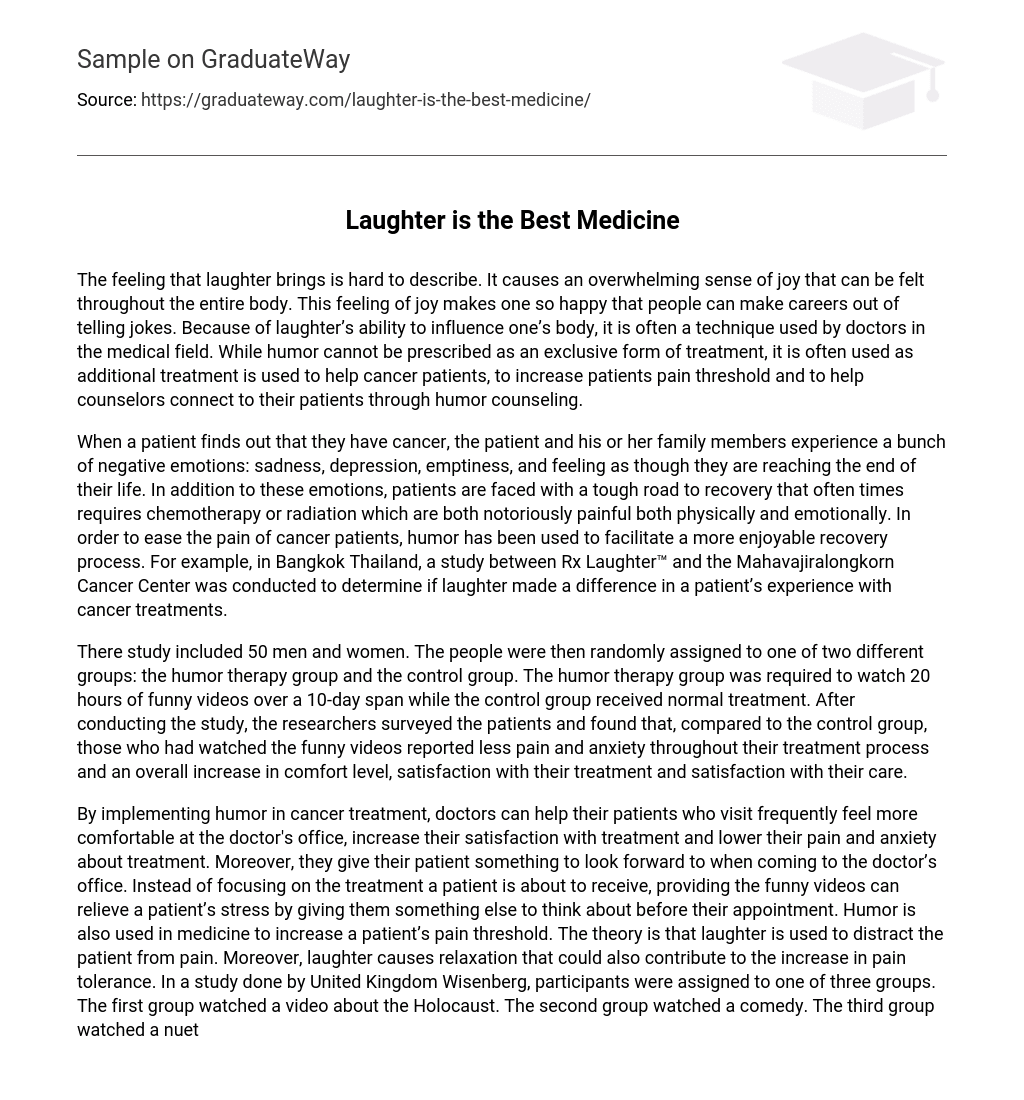The feeling that laughter brings is hard to describe. It causes an overwhelming sense of joy that can be felt throughout the entire body. This feeling of joy makes one so happy that people can make careers out of telling jokes. Because of laughter’s ability to influence one’s body, it is often a technique used by doctors in the medical field. While humor cannot be prescribed as an exclusive form of treatment, it is often used as additional treatment is used to help cancer patients, to increase patients pain threshold and to help counselors connect to their patients through humor counseling.
When a patient finds out that they have cancer, the patient and his or her family members experience a bunch of negative emotions: sadness, depression, emptiness, and feeling as though they are reaching the end of their life. In addition to these emotions, patients are faced with a tough road to recovery that often times requires chemotherapy or radiation which are both notoriously painful both physically and emotionally. In order to ease the pain of cancer patients, humor has been used to facilitate a more enjoyable recovery process. For example, in Bangkok Thailand, a study between Rx Laughter™ and the Mahavajiralongkorn Cancer Center was conducted to determine if laughter made a difference in a patient’s experience with cancer treatments.
There study included 50 men and women. The people were then randomly assigned to one of two different groups: the humor therapy group and the control group. The humor therapy group was required to watch 20 hours of funny videos over a 10-day span while the control group received normal treatment. After conducting the study, the researchers surveyed the patients and found that, compared to the control group, those who had watched the funny videos reported less pain and anxiety throughout their treatment process and an overall increase in comfort level, satisfaction with their treatment and satisfaction with their care.
By implementing humor in cancer treatment, doctors can help their patients who visit frequently feel more comfortable at the doctor’s office, increase their satisfaction with treatment and lower their pain and anxiety about treatment. Moreover, they give their patient something to look forward to when coming to the doctor’s office. Instead of focusing on the treatment a patient is about to receive, providing the funny videos can relieve a patient’s stress by giving them something else to think about before their appointment. Humor is also used in medicine to increase a patient’s pain threshold. The theory is that laughter is used to distract the patient from pain. Moreover, laughter causes relaxation that could also contribute to the increase in pain tolerance. In a study done by United Kingdom Wisenberg, participants were assigned to one of three groups. The first group watched a video about the Holocaust. The second group watched a comedy. The third group watched a nuetral video. While watching the video, the participants put their arms in a bucket of cold water and were asked to rate their pain. After watching the video for half an hour, the group that watched the funny video reported a higher pain tolerance or lower overall pain. A version of this test was also conducted by the University of California, Los Angeles (UCLA) and Rx Laughter™ with children. They tested pain tolerance by having all of the participants watch funny videos, but one group watched the video before putting their arm in the cold water.
One group watched the video while their arm was in the cold water, and the last group watched the video after putting their arm in the cold water. They found that children who watched the video while their arm was in the cold water had the greatest pain tolerance. Just by watching a funny video, patients were able to increase the amount of pain that they can withstand. This is important because doctors can use humor therapy in combination with procedures that are notoriously painful to ease patients pain. One could argue that putting one’s arm in cold water does not compare to painful treatments that many patients undergo, and even though it raises pain tolerance, it may not raise it enough to be effective in cases where it is actually needed; however, this is not true. Many hosptials use a form of humor therapy known as clowning.
Clowning is where people dress up as clowns and wander around the hospitals trying to make people laugh. The hope is that they will ease the stress and anxiety associated with doctor’s offices and help ease the pain of patients going through tough procedures. Clowning is especially effective for children because it distracts them from the pain associated with the procedure that the doctor is performing on them. Peter Spitzer is one of these clowns and shares one of his experiences.





